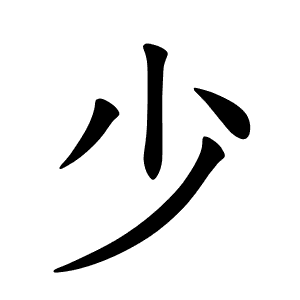少
- few, young;
Means “few, little (in quantity),” “to decrease,” or “young.”
Etymology
In Oracle Bone Script, written as four small dots, emphasizing the idea of “few.”
The primary meaning is “few (in number),” distinct from “small (in size)” expressed by 小.
Also conveys “young,” extending from the sense of “few in years.”
Usage in Korean
Very common in Korean compounds:
少年 (소년) - youth, young person;
少女 (소녀) - girl, maiden;
多少 (다소) - more or less, to some extent;
減少 (감소) - decrease, reduction;
稀少 (희소) - rare, scarce;
최소 (最少) - the least, minimum.
Distinct from 小 (so, “small in size”), even though both share similar readings in Korean.
Antonyms:
- for “few”: 多 (da, “many”);
- for “young”: 老 (ro, “old”).
Words that derived from 少
Alternative forms
Note that in Japanese Kanji, Korean Hanja and Vietnamese Nom, the middle stroke of the top component 小 is written 亅 with a hook whereas in modern Chinese scripts the middle stroke is written 丨 with no downward hook.
尐 (jeol): a rare variant form of 少, where the bottom stroke 丿 is changed to 乀.
Still listed in the Kangxi Dictionary (康熙字典, vol. 296).
In Cantonese:
“few, small” → zit3.
“cicada (꽃매미)” → zit1.
- 火竹 (FH)
- ⿱ 𡭔 丿 (G T)
- ⿱ 小 丿 (H J K V)
